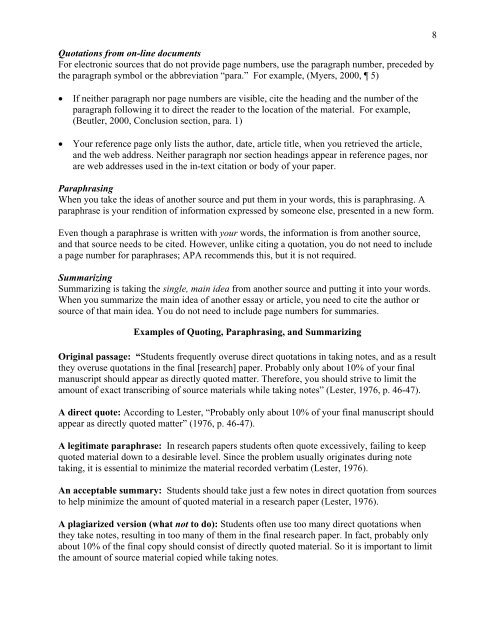What is plagiarism, and why is it important at Franklin ... - My Franklin
What is plagiarism, and why is it important at Franklin ... - My Franklin
What is plagiarism, and why is it important at Franklin ... - My Franklin
- No tags were found...
You also want an ePaper? Increase the reach of your titles
YUMPU automatically turns print PDFs into web optimized ePapers that Google loves.
Quot<strong>at</strong>ions from on-line documents<br />
For electronic sources th<strong>at</strong> do not provide page numbers, use the paragraph number, preceded by<br />
the paragraph symbol or the abbrevi<strong>at</strong>ion “para.” For example, (<strong>My</strong>ers, 2000, 5)<br />
• If ne<strong>it</strong>her paragraph nor page numbers are v<strong>is</strong>ible, c<strong>it</strong>e the heading <strong>and</strong> the number of the<br />
paragraph following <strong>it</strong> to direct the reader to the loc<strong>at</strong>ion of the m<strong>at</strong>erial. For example,<br />
(Beutler, 2000, Conclusion section, para. 1)<br />
• Your reference page only l<strong>is</strong>ts the author, d<strong>at</strong>e, article t<strong>it</strong>le, when you retrieved the article,<br />
<strong>and</strong> the web address. Ne<strong>it</strong>her paragraph nor section headings appear in reference pages, nor<br />
are web addresses used in the in-text c<strong>it</strong><strong>at</strong>ion or body of your paper.<br />
Paraphrasing<br />
When you take the ideas of another source <strong>and</strong> put them in your words, th<strong>is</strong> <strong>is</strong> paraphrasing. A<br />
paraphrase <strong>is</strong> your rend<strong>it</strong>ion of inform<strong>at</strong>ion expressed by someone else, presented in a new form.<br />
Even though a paraphrase <strong>is</strong> wr<strong>it</strong>ten w<strong>it</strong>h your words, the inform<strong>at</strong>ion <strong>is</strong> from another source,<br />
<strong>and</strong> th<strong>at</strong> source needs to be c<strong>it</strong>ed. However, unlike c<strong>it</strong>ing a quot<strong>at</strong>ion, you do not need to include<br />
a page number for paraphrases; APA recommends th<strong>is</strong>, but <strong>it</strong> <strong>is</strong> not required.<br />
Summarizing<br />
Summarizing <strong>is</strong> taking the single, main idea from another source <strong>and</strong> putting <strong>it</strong> into your words.<br />
When you summarize the main idea of another essay or article, you need to c<strong>it</strong>e the author or<br />
source of th<strong>at</strong> main idea. You do not need to include page numbers for summaries.<br />
Examples of Quoting, Paraphrasing, <strong>and</strong> Summarizing<br />
Original passage: “Students frequently overuse direct quot<strong>at</strong>ions in taking notes, <strong>and</strong> as a result<br />
they overuse quot<strong>at</strong>ions in the final [research] paper. Probably only about 10% of your final<br />
manuscript should appear as directly quoted m<strong>at</strong>ter. Therefore, you should strive to lim<strong>it</strong> the<br />
amount of exact transcribing of source m<strong>at</strong>erials while taking notes” (Lester, 1976, p. 46-47).<br />
A direct quote: According to Lester, “Probably only about 10% of your final manuscript should<br />
appear as directly quoted m<strong>at</strong>ter” (1976, p. 46-47).<br />
A leg<strong>it</strong>im<strong>at</strong>e paraphrase: In research papers students often quote excessively, failing to keep<br />
quoted m<strong>at</strong>erial down to a desirable level. Since the problem usually origin<strong>at</strong>es during note<br />
taking, <strong>it</strong> <strong>is</strong> essential to minimize the m<strong>at</strong>erial recorded verb<strong>at</strong>im (Lester, 1976).<br />
An acceptable summary: Students should take just a few notes in direct quot<strong>at</strong>ion from sources<br />
to help minimize the amount of quoted m<strong>at</strong>erial in a research paper (Lester, 1976).<br />
A plagiarized version (wh<strong>at</strong> not to do): Students often use too many direct quot<strong>at</strong>ions when<br />
they take notes, resulting in too many of them in the final research paper. In fact, probably only<br />
about 10% of the final copy should cons<strong>is</strong>t of directly quoted m<strong>at</strong>erial. So <strong>it</strong> <strong>is</strong> <strong>important</strong> to lim<strong>it</strong><br />
the amount of source m<strong>at</strong>erial copied while taking notes.<br />
8


